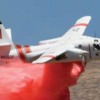Bill,
At the outset, I think I understand the purpose of your question (always a danger, I know). Would the use of a flame-retardant material lessen the chance of a vehicle fire, or reduce the scope of the fire if one occurs?
Answer: Not really.
Background: Flame retardant materials are usually added to combustible materials to render them less flammable. The example we are familiar with is spray-on products for house roofs and siding. The material saturates the flammable material and helps it to avoid igniting when an outside ignition source is added, such as burning vegetation, forest fire, neighboring structure, etc.
In our cars, the situation is reversed. The materials that would receive the fire-retardant material are not themselves flammable, composed mainly of various metals. The flammable nature of car fires comes from the fuel used, usually gasoline, as well as assorted greases and oils that cover the hard surfaces.
These gasses and oils will still burn, no matter if the undercoat is flame-retardant or not. A better use of our time and money is to install an approved extinguisher, preferably fixed-mounted, and use all of our senses to periodically inspect the engine compartment, looking at mounting for fuel lines, touching the lines for hardness, smelling for the presence of a fuel leak. If you have access to the underbody, do the same inspection as you would for the engine compartment. If you mount a portable extinguisher, the halon derivatives extinguish the fire with no messy residue.
In case of a car fire, property damage is secondary to physical harm. First, consider occupant safety, both passengers and driver, then activate extinguishers. If you never practice the above, you will be struck stupid at your first car fire.








